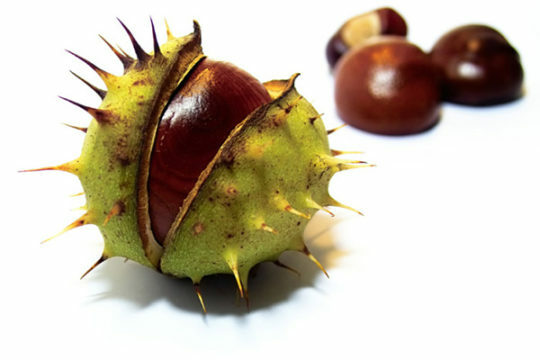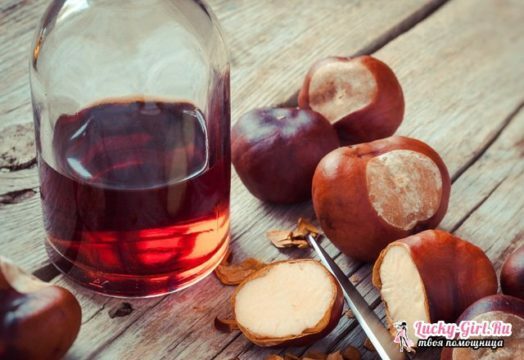One of the most common diseases of the male sexual sphere is prostatitis. This disease is getting younger every year - if before the urologist with this problem men mostly addressed after 50 years, now young people after the age of 35 also become patients of the urological department.
Prostatitis is a disease that develops in the prostate gland. It is an inflammatory process that affects the genitourinary system of a man. Along with medicamental therapy, treatment is widely used in people's ways. Many herbs and plants help cope with the disease, eliminate some of the symptoms of the disease. The most popular is chestnut with prostatitis.

About prostatitis
The first signs of a nascent disease is the problem of urination. With prostatitis, a man observes the following symptoms:
- Problems in intimate life. There are problems with erection, ejaculation;
- Appearance of aching or vice versa sharp pains in the lower abdomen, often giving up in the leg or lower back;
- Impossibility to completely empty the bladder. The urge to urinate becomes too frequent, the process can be accompanied by pain.
The following male representatives are at risk for developing the disease:
- Males leading a low-activity lifestyle;
- Fans of winter sports, diving. With frequent supercooling of the pelvic organs, the probability of inflammation of the prostate increases;
- Young people leading a promiscuous sex life. In this case, infection in the genito-urinary system and the onset of an inflammatory process are possible. Frequent interruption of sexual intercourse can also cause prostatitis.
Prostatitis, like any other disease, is better treatable at the initial stage of the disease. Doctors distinguish two forms of the course of the disease: acute and chronic.
In acute forms of the disease, the patient is disturbed by the following symptoms: intermittent urination, pain in the lower abdomen, problems in intimate life, body temperature may increase. In rare cases, purulent discharge appears. To identify the disease, the following types of diagnostics are performed: ultrasound, palpation, blood test, swab for venereal diseases. Treatment is carried out in a hospital, with the help of antibiotics, drugs that remove edema, physioprocedures.
The chronic form of prostatitis is usually a neglected form of the acute form. Untimely treatment, non-observance of prescriptions of the doctor can lead the patient to a chronic course of the disease. Symptoms of chronic prostatitis in many ways similar to the previous form, treatment usually lasts several months. The presence of bad habits only delay the therapy
Treatment of prostatitis with horse chestnut
For the treatment of prostatitis, not only medications are used. For more effective treatment, it is possible to use complex therapy, which includes medicines and traditional medicine. Very popular are decoctions and tinctures made from horse chestnut.
 People have been using chestnut for a long time to fight prostatitis. It contains substances that improve blood circulation, have an antiseptic effect. Routine, pectin substances, esculin have a beneficial effect not only on the prostate gland, but also on the whole organism.
People have been using chestnut for a long time to fight prostatitis. It contains substances that improve blood circulation, have an antiseptic effect. Routine, pectin substances, esculin have a beneficial effect not only on the prostate gland, but also on the whole organism.
Useful properties of chestnut:
- Strengthening blood vessels, improving the outflow of blood from the prostate;
- Improves the production of testosterone;
- Increased immunity with vitamins E, C;
- In the chestnut tannins are present, which kill microbes and relieve the inflammatory process from the gland;
- Increased content of iodine, zinc improve the general condition of the body.
As with any medicine, the use of chestnut is contraindicated in the following cases:
- Poor blood clotting;
- Internal bleeding;
- Low pressure.
Recipes for infusions and decoctions of chestnut
For the treatment of prostatitis, not only the fruits of the tree, but also its flowers are used. Here are a few recipes from the blossoming part of the chestnut:
Six tablespoons of chestnut flowers pour a small amount of olive or refined oil. The mixture should be infused for at least a month in a dark and cool place. The manufactured ointment is rubbed into the sore spot.
For the removal of the inflammatory process, enemas from the peel of chestnut are good. The recipe is very simple - the peel is poured with boiling water along with the needles. The broth should be cooled to room temperature and used as a micro-enema at night.
Take 30 grams of peel and pour it 300 ml of vodka. The infusion of vodka should stay at least three weeks in a dark cool place. The fluid must be constantly shaken. Then, the resulting mixture is filtered and 150 ml of boiled water is added to it. The tincture is taken twice a day, 10 drops each. The course of treatment should be at least two weeks, then a break is made and repeated again.
The crushed shell is poured with boiled water. For 2 grams of powder you need to take half a liter of water. Next, the mixture must be filtered and placed on a water bath. Ready-made broth should be about 200 ml. The drug is taken at thirty drops three times daily before meals. It is best to keep the broth in the refrigerator. For more effective treatment, the course is repeated three times a year.
Horse chestnut is widely used in decoctions and tinctures with other medicinal plants. Chamomile is known for its anti-inflammatory effect, so the broth from chestnut and chamomile has a beneficial effect on the prostate.
Peel two fruits in the boiling water.500 ml of liquid will be enough. This mixture is cooked for about two hours, then add two tablespoons of dry chamomile inflorescences. Decoction to remove from heat, cover and let it brew. Chill the filtered mixture and drink twice a day, one glass.
Chestnut from prostatitis can not only remove the first symptoms of the disease, but to provide a preventive effect. A special broth from the peel of chestnut can be drunk instead of tea for a long time.
For its preparation, it is necessary to release the fruits from the peel and pour into the thermos. Then pour all the boiling water and come the night. The broth is taken a month, then a break is made, and so do during the year.
For preservation of all useful properties of a medicinal plant, it is necessary to collect and prepare a chestnut properly. In folk medicine, not only the fruits of the tree, but also flowers and leaves are used.
Flowers are collected during flowering in spring and dried. The period of collection of leaves is much greater - they can be collected from May to the first of September. Fruits are collected at a time when they are self-ripe and fallen from the tree. Fruits, torn off on their own, are considered poorly ripe and have less healing properties. Dry the fruit tree in a well-ventilated room, at least four weeks. Well-dried chestnuts are stored in a dark dry place.
In folk medicine, there are many recipes for horse chestnut against prostatitis. For medicinal purposes, leaves, flowers, fruits are used. Chestnut extract contains esculin, fractin, fatty oils. Tinctures and broths help to remove puffiness, reduce pain symptoms. However, do not forget that in chronic forms of prostatitis, the most effective treatment is complex therapy, which consists of medicines and recipes of traditional medicine.



